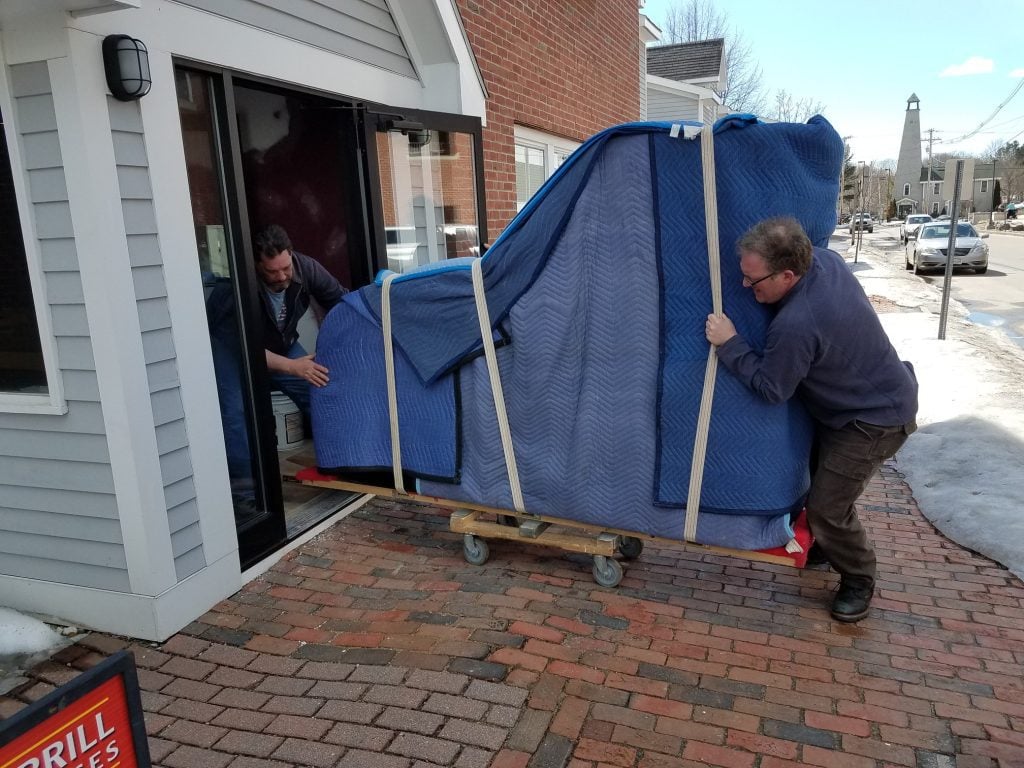Piano movers near me? Who do I contact?
The United States
The best place to look first is your local piano store. Even if they don’t move pianos themselves (and they might), they’ll know what movers are available in your area. Most importantly, they’ll be aware who is reputable and competent, which you can’t always divine from online reviews alone.
Here in the United States, there’s an online directory of piano stores called PianoStoresUSA.com. This directory is a great place to start.
Southern Maine
There are two well-established piano moving companies here in Southern Maine: The Piano Movers of Maine (207-939-3018) and Starbird Piano (207-775-2733), both of which are based in Portland. Both, in my experience, are willing to travel pretty far. If you’re a bit further up north, Gordon Large (207-458-4176) operates out of Farmingdale.
Pricing for piano moving is quite variable, and you should have the following information ready: The location the piano is moving from and to; The number of steps at both locations; The size of the piano (length for a grand or height for an upright).
If you require an especially long-distance move between states, reach out to Piano Movers Inc. They service all of New England.
Do I really need a professional piano mover?
Pianos weigh many hundreds of pounds (about 400 for the smallest spinets and 1200 for the largest grands). They can also move unpredictably because of their often dramatically uneven weight distribution. Although moving a piano poorly could damage it, the real risk is to the people and the environment. On a flight of stairs, a piano can quickly transform into an unstoppable battering ram, leaving a path of devastation behind it.
The typical rule of thumb is to call a professional if either you’re moving a grand piano, or if you’re moving an upright and more than three stairs are involved at either location.

How much does piano moving cost?
Moving a piano is a task that requires careful planning and consideration of several factors that can influence the overall cost. Key elements to keep in mind include:
Type and Size of the Piano
The dimensions and weight of your piano play a significant role in determining moving expenses. Larger instruments, such as grand pianos, are heavier and more complex to transport compared to smaller uprights, often resulting in higher costs. The legs and lyre have to be removed from grand pianos.
Distance of the Move
The mileage between the piano’s current location and its destination directly impacts the price. Local moves are generally less expensive, while long-distance relocations incur higher charges due to increased fuel, labor, and time requirements.
Accessibility Challenges
Factors like the presence of stairs, narrow hallways, tight corners, or limited access can complicate the moving process. Such challenges may necessitate additional labor or specialized equipment, thereby increasing the overall cost. For instance, I helped with a move where the grand piano had to be lifted seven feet in the air and spun in order to negotiate a landing on a staircase.
Insurance and Liability Coverage
One of the advantages of professional movers is that they’re covered by insurance! Pianos themselves are valuable, but they can also be incredibly destructive. You’re protected from this potential damage (which may include life and limb) when you hire a professional, but it adds to their costs and the overall expense.
Given these variables, piano moving costs can vary widely. For instance, relocating an upright piano could cost as little as $300, whereas a move from one side of the country to the other could be $2000.
It’s important to note that these figures are general estimates, and actual costs can differ based on regional market conditions and specific circumstances. To obtain an accurate quote, it’s advisable to consult with professional piano movers who can assess the unique aspects of your situation.
Can I just use a regular moving company?
Typical household movers don’t have adequate experience taking pianos apart and putting them back together. They might be able to move an upright, but grands are another matter altogether. I regularly have to reinstall pedal lyres that were improperly installed by movers. I’ve also cleaned up after several piano drops (one of which trapped a person). These are nightmare experiences for everybody involved. These are typically caused by the piano moving in a way the mover didn’t expect, given their uneven weight distribution. If at all possible, choose somebody with substantial experience moving pianos!
I once was called in to help “experienced piano movers” remove the legs from a Steinway. They couldn’t figure out how they came off! I won’t name the company, but it was a large, local moving firm, and they’d begun attempting to remove the bolts holding the key bed to the rest of the cabinet when I arrived. If they’d succeeded, it would have been quite the insurance claim!
If you have any other questions, please reach out to me on my contact page.
Can I move a piano by myself? Or with some friends?
Pianos are put together using a very large cast iron plate, and they’re very heavy! Even smaller spinets weigh at least 400 pounds. Worse, they tend to move in a somewhat unpredictable manner, as the weight isn’t centered inside the instrument.
Grand pianos need to be disassembled to move, even if it’s just between rooms. The disassembly process needs to be done carefully to prevent damage to the instrument, and is best left to those with experience!
Upright pianos do not require disassembly to move. However, as a rule of thumb, you should never move a piano yourself if more than three steps are involved. From one end of the room to another? Sure. Over a threshold? You’ll probably make it! However, if a flight of stairs are involved, you should leave it to the professionals. A falling piano is capable of causing considerable damage to person and property.
Last updated on April 13, 2025